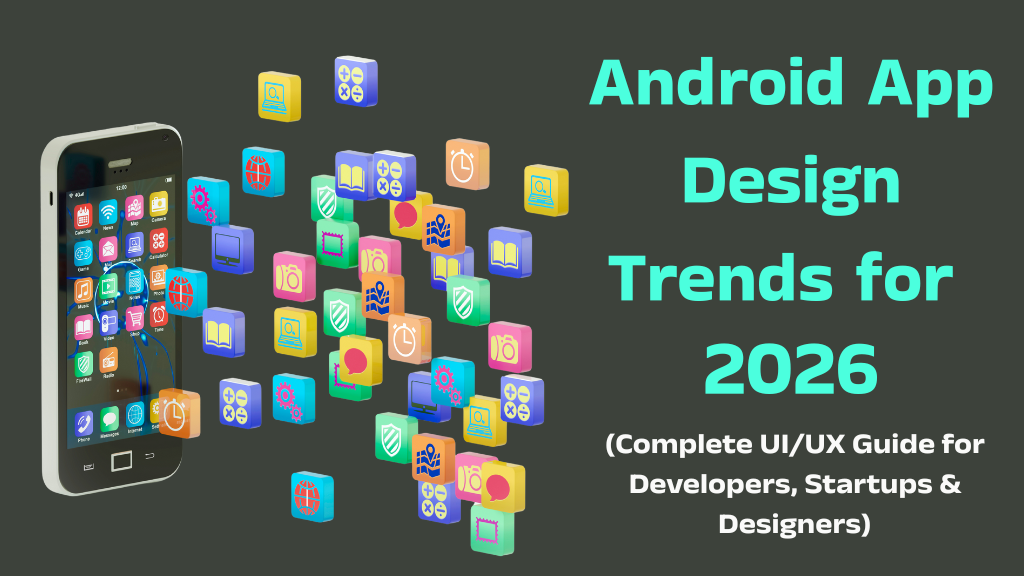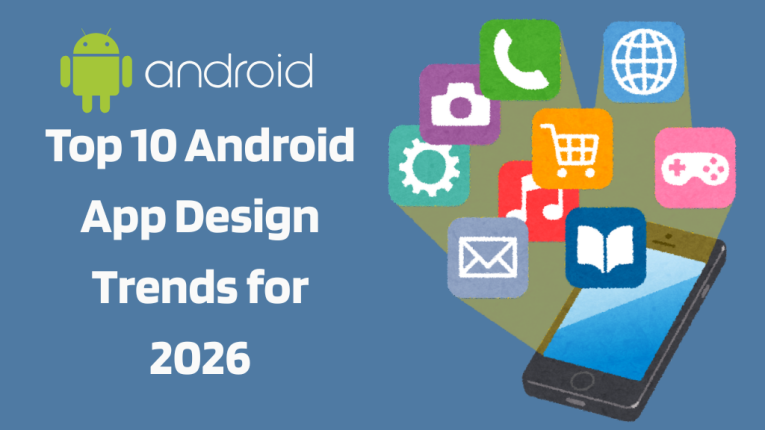


Tejhaksh Technologies is the Website designing & Digital Marketing company based in Neemuch, established in 2020 providing Website design, Website development, Logo design, Domain Registration, Web hosting, Android App Development, eCommerce web development, Search Engine Optimization, Bulk SMS etc. We have good experience in developing different platform websites and we keep our eye on the latest technologies to implement on the website for better conversion and user experience.

The world of Android app design is changing rapidly. In 2026, mobile apps will work very differently as AI, 5G, foldable phones, motion interfaces, and custom experiences become mainstream.
If you’re a UI/UX designer, app developer, or business owner, it’s crucial to stay abreast of these new trends so you can create apps that are fast, smart, and user-friendly.
In this guide, we’ll explore the biggest Android app design trends for 2026 and how to implement them into your apps to achieve better user experiences, greater engagement, and higher conversions.
By 2026, AI-powered Android apps will become a key part of every modern UI/UX design. Artificial intelligence is no longer just a feature, but a core tool that makes apps smarter, faster, and more personal.
With AI, apps will understand user preferences, make relevant recommendations, and deliver a unique experience for each individual. In the future, AI personalization will shape how users engage with apps—making designs even more intuitive and future-ready.
Today’s users want apps that instantly understand their needs. They expect apps to think like them, recognize their preferences, and make the right recommendations at the right time. With AI allows apps to show content based on each user’s needs, which reduces effort, saves time, and makes the overall experience smoother and better.
With increasing competition in the Play Store, personalization is no longer an option—it’s essential for app growth.
✔ Personalized Home Screen – The app will automatically adapt its layout, shortcuts, and content based on your habits and usage patterns.
✔ AI-Generated UI Layout – Smart algorithms make the app easier and smoother by transforming what’s on the screen in real-time.
✔ Adaptive Color Theme – The app’s colors automatically change based on your mood, time, location, and ambient lighting.
✔ Predictive Search and Smart Suggestions – The app shows you relevant suggestions and relevant results before you even type.
✔ Advanced Voice Navigation – Navigating the app by voice will be even easier, with improved understanding, natural responses, and support for multiple languages.
The growing AI personalization in 2026 demonstrates that the entire industry now desires technology that understands and responds like humans. Apps that use AI effectively will reap significant benefits—including more user retention, faster onboarding, increased app usage, and improved conversions.
AI provides a personalized and engaging experience for every user, helping them stay on the app longer.
Therefore, businesses that adopt AI now will be positioned to benefit from a strong and long-term advantage in the future.
Minimalist Android design is becoming increasingly popular in 2026, where simplicity, clean screens, and easy navigation are increasingly emphasized. Today’s users prefer apps that look neat and simple, not messy or overloaded with elements. They want screens that feel clean and easy to use.
Clean designs with extra space and minimal elements make the app experience clearer and more comfortable. This is why minimalism has become one of the strongest and most future-changing trends in modern Android UI design.
Minimalist design isn’t just about looking good—it also improves an app’s actual performance. When the interface is clean and less cluttered, it offers several benefits:
For this reason, minimalism will remain a crucial part of any modern and professional UI design in 2026 and for years to come.

When foldable smartphones become commonplace in 2026, apps will also need to adapt to these flexible screens. Foldable app design means the app layout automatically transitions seamlessly from a smaller screen view to a larger, dual-screen view, providing a smooth and comfortable user experience in each mode.
Key Focus Areas:
Practical Uses:
Apps that adopt the Android dual-screen UI and foldable smartphone trends will feel more modern, simple, and future-ready—other apps may feel outdated.
Micro-animations and motion UI will become an essential part of Android design in 2026. Small motion effects not only improve an app’s look but also build a stronger bond with users. These animations provide instant feedback and help the user understand what’s happening within the app. This makes the overall experience smoother, easier to understand, and more enjoyable to use.
Motion design makes apps more vibrant and engaging. Small animations illustrate what’s happening in the app, making it easier to understand. This helps users focus faster and reduces the effort required to use the app. Overall, Motion UI makes app navigation easier and the overall experience more enjoyable and smooth.
As AI voice assistants become smarter and more accurate in 2026, Android app design is rapidly shifting toward voice-based interfaces instead of touch. People will now be able to operate apps simply by speaking—making things faster, easier, and hands-free. Conversational UIs are poised to be the biggest Android UX trend of 2026.
Use voice search everywhere:
– Smart, conversation-like responses powered by AI
– Voice navigation within apps
– Hands-free content creation and control
Where it works best:
– Fitness apps
– Maps and navigation
– Shopping apps
– Task management tools
In 2026, users won’t like reading long texts or looking at boring static info. People now want apps that display information quickly, clearly, and at the point they need it, allowing them to make quick decisions. This is why highly personalized dashboards and interactive data visuals are now essential in modern Android apps. Apps with animated and responsive visuals feel more professional and provide a better, interactive experience.
Dark Mode has been a favorite for years, but in 2026, it’s getting a new incarnation—Dark Mode 2.0. This is a smarter, more flexible, and more battery-efficient version designed for modern Android systems. It features deeper blacks, smarter settings that adapt to light, and a better reading experience. This makes this new Dark Mode a must-have feature in modern UI design.
Dark Mode 2.0 not only looks great but also improves user convenience. It improves readability, saves battery on AMOLED phones, and automatically adjusts to changing environments. Apps with Smart Dark Mode will appear more modern, premium, and easier to use in 2026.
Modern Android screens are now virtually bezel-less, making the entire display feel even more immersive. This has led to the need for edge-to-edge UI layouts in app design, ensuring every aspect of the screen is utilized effectively.
Key Characteristics
Full-screen backgrounds
Floating navigation bars
Transparent status bar elements
Rounded-edge card designs
This makes apps look modern, high-end, and more engaging.
By 2026, most Android apps will use gesture-based navigation. This will reduce the need for traditional buttons and allow users to navigate apps with simple gestures like swiping, tapping, or sliding. This will make their experience faster, cleaner, and more intuitive.
This change demonstrates how gesture navigation is transforming modern Android apps, making them smarter, simpler, and more user-friendly.
In 2026, energy-efficient and environmentally conscious UI/UX designs will be in high demand. Both users and app stores will favor apps that use less power and are environmentally conscious.
Apps that utilize eco-friendly UI design, sustainable Android UI/UX, and energy-efficient design trends are more likely to rank higher on the Play Store. Such apps also quickly attract environmentally conscious users, who prefer clean, lightweight, and energy-efficient digital solutions.
Android app design is changing rapidly. To succeed in 2026, app developers will need to adopt smart and future-ready UI/UX.
Key focuses in Android app design will include:
By adopting these trends, developers can create a better user experience, increase app rankings, and build modern, future-proof apps.
Leave a Comment